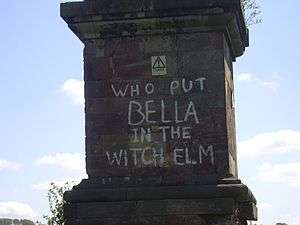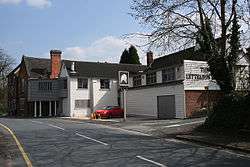Who put Bella in the Wych Elm?

Who put Bella in the Wych Elm? is a graffito that originated in 1944 after a woman's corpse was discovered by several children inside a wych elm near Wychbury Hill at Stourbridge, Worcestershire, England.
The graffiti has appeared in numerous places throughout England, most notably on the Wychbury Obelisk near the forest where the woman's body was discovered. The victim, whose murder was estimated to have occurred in 1941, remains unidentified.
History
On 18 April 1943, four local boys (Robert Hart, Thomas Willetts, Bob Farmer and Fred Payne) were poaching in Hagley Wood near to Wychbury Hill when they came across a large wych elm.[1][Notes 1] The wood is part of the Hagley estate belonging to Lord Cobham.[2][3]
Thinking it a good place to hunt birds' nests, Farmer attempted to climb the tree to investigate. As he climbed, he glanced down into the hollow trunk and discovered a skull. At first he believed it to be that of an animal, but after seeing human hair and teeth, he realized that he had found a human skull. As they were on the land illegally, Farmer put the skull back and all four boys returned home without mentioning their discovery to anybody.[4]

On returning home, the youngest of the boys, Tommy Willetts, felt uneasy about what he had witnessed and decided to report the find to his parents. When police checked the trunk of the tree they found an almost complete skeleton, with a shoe, a gold wedding ring, and some fragments of clothing. After further investigation, the remains of a hand were found some distance from the tree.[4]
The body was sent for forensic examination by Prof. James Webster. He quickly established that it was that of a female who had been dead for at least 18 months, placing time of death in or before October 1941; Webster also discovered a section of taffeta in her mouth, suggesting that she had died from suffocation. From the measurement of the trunk in which the body had been discovered, he also deduced that she must have been placed there "still warm" after the killing, as she could not have fit once rigor mortis had taken hold.[4]
Since the country was then in the midst of World War II, identification was seriously hampered. Police could tell from items found with the body what the woman had looked like, but with so many people reported missing during the war, records were too vast for a proper identification to take place. The current location of her skeleton is unknown, as is that of the autopsy report.[4]

In a Radio 4 programme first broadcast in August 2014 Steve Punt suggested two possible victims.[4]
The first possibility came from a statement made to police in 1953 by Una Mossop, in which she said that her cousin Jack Mossop had confessed to family members that he and a Dutchman called van Ralt had put the woman in the tree. Mossop and van Ralt met for a drink at the Lyttelton Arms (a pub in Hagley). With van Ralt was a Dutchwoman. Later that night, Mossop said the woman became drunk, and passed out while they were driving. The men put her in a hollow tree in the woods in the hope that in the morning she would wake up and be frightened into seeing the error of her ways.[5]
Jack Mossop was confined to a Stafford mental hospital, because he had reoccurring dreams of a woman staring out at him from a tree. He died in the hospital before the body in the wych elm was found.[5] The likelihood of this being the correct explanation is questioned because Una Mossop did not come forward with this information until more than ten years after Jack Mossop's death.[6]
A second possible victim was reported to the police in 1944 by a Birmingham prostitute. In the report she stated that another prostitute called Bella, who worked on the Hagley road, had disappeared about three years previously.[7]
Graffiti
In 1944 the first graffito message related to the mystery appeared on a wall in Upper Dean Street, Birmingham, reading Who put Bella down the Wych Elm - Hagley Wood.[8]
On 18 August 1999, the phrase "Who put Bella in the Witch Elm?" (sic) was daubed on the outward-facing side of the 200-year-old Wychbury Obelisk, in white paint.
In early June 2016, a cardboard placard appeared next to a fence on the A456 near Hagley Woods. Although not as elaborate as the 1999 graffito, the 2016 sign bore the infamous words "Who put Bella in the Wych Elm?", rekindling the 73-year old question. It is most likely that this cardboard sign was inspired by the local mystery, rather than any knowledge of the events, and placed to attract the interest of people unfamiliar with the story. The difference in spelling and methodology makes it very unlikely that the 1999 and 2016 graffiti are connected.
Starting in the early 2000s, the story has spread throughout Europe, especially England, Germany and Italy, and spawned many variations. The girl's name has been changed into Blanche, Sophie or Susi, while the rest of the tale is quite consistent to the main story. Graffiti messages with the phrases "Where is Sophie", "Wo ist Susi?" and such are repeatedly spotted up to the day in many isolated places, especially in rural areas. [9]
Cultural references
- Composer Simon Holt wrote a 2002 musical theatre piece about the mystery, entitled "Who Put Bella in the Wych Elm?"
- Stourbridge Theatre Company put on a play entitled Bella in the Wych-Elm, written by Stourbridge playwright and historian David Morris, in 2007
- Songwriter Owen Tromans included a song called "Bella in the Witch Elm" on his 2013 EP For Haden.[10]
- The song "Nail House Music" by American post-punk band Self Defense Family references the mystery, with the lyrics repeatedly asking "who put you in the witch elm?"
Notes
- ↑ The Independent named the species as "wych–hazel", an old synonym for the same kind of elm.
References
- ↑ Vale, Allison. "Is this the Bella in the wych elm? Unravelling the mystery of the skull found in a tree trunk". The Independent. Retrieved 27 February 2014.
- ↑ "Murder mystery returns to haunt village". BBC News. 12 August 1999. Retrieved 30 July 2010.
- ↑ Askwith, Richard (18 August 1999). "Mystery. Murder. And half a century of suspense". The Independent. Retrieved 30 July 2010.
- 1 2 3 4 5 Punt, Steve (2 August 2014). "Who Put Bella in the Wych Elm?". "Punt PI", series 7 episode 4. BBC Radio 4. Retrieved August 2014. Check date values in:
|access-date=(help) - 1 2 Punt 2014, 24 minutes.
- ↑ Punt 2014, 26 minutes.
- ↑ Punt 2014, 27 minutes.
- ↑ Joyce M. Coley, Bella: An Unsolved Murder (Studley, Warwickshire: History into Print, 2007), p.9.
- ↑ http://www.paranormale.com/
- ↑ Owen Tromans - For Haden (CD) at Discogs
External links
- "Who Put Bella in the Wych Elm" article on Atlas Obscura
- Who Put Bella in the Wych Elm Extensive article from Brian Haughton's website